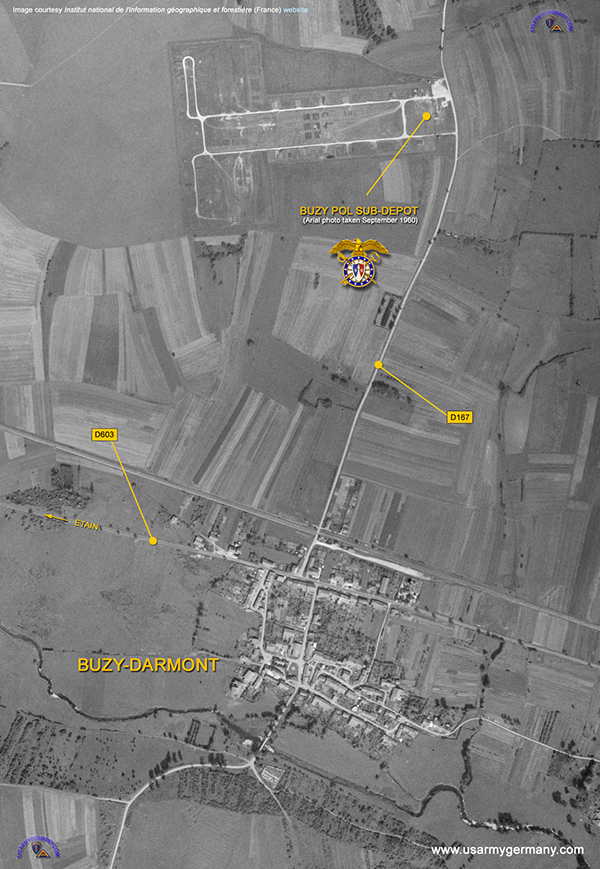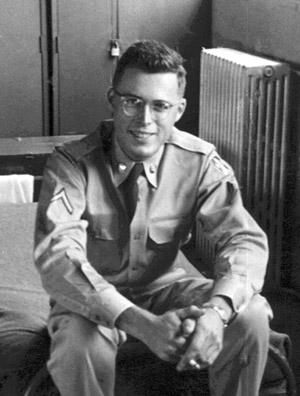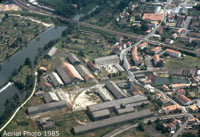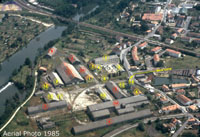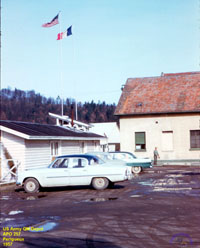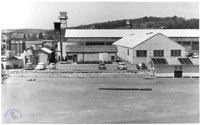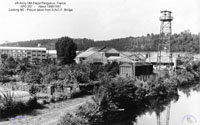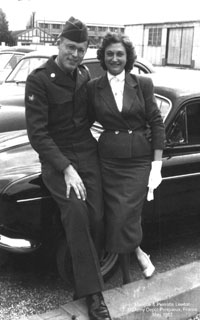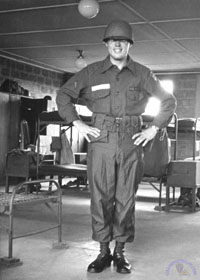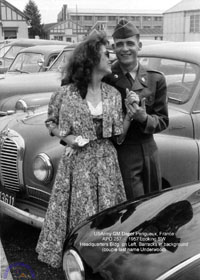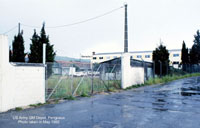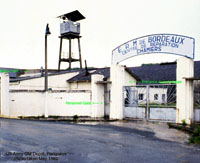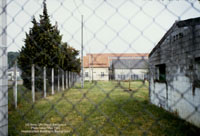| If you do
NOT see the Table of Contents frame to the left of this page, then
Click here to open 'USArmyGermany' frameset |
||||||||||||||||||||||||||||||||||||||||||||||||||||||||
|
Army Quartermaster Depots (Com Z) |
||||||||||||||||||||||||||||||||||||||||||||||||||||||||
|
|
||||||||||||||||||||||||||||||||||||||||||||||||||||||||
|
||||||||||||||||||||||||||||||||||||||||||||||||||||||||
|
|
||||||||||||||||||||||||||||||||||||||||||||||||||||||||
| Ingrandes Quartermaster Depot | ||||||||||||||||||||||||||||||||||||||||||||||||||||||||
%20at%20Ingrandes%20600.jpg) US Army RS-4-TC engine at Ingrandes Depot, 1960s (Webmaster's collection) |
||||||||||||||||||||||||||||||||||||||||||||||||||||||||
| 1954 | ||||||||||||||||||||||||||||||||||||||||||||||||||||||||
| (Source: STARS & STRIPES, Jan 11, 1954) | ||||||||||||||||||||||||||||||||||||||||||||||||||||||||
| The Ingrandes Quartermaster Depot was activated in March 1952. At that time Lt Col Homer E. Long and a small detachment set up operations on a 40-acre former French ammo dump. The had to initially clear the area of thousands of dud explosives. Until September 1952, Ingrandes was a sub-depot of the Perigueux QM Depot. At that time the roles were reversed. Today the depot, under the command of COL Jack E. Weske, covers 131 acres and many new prefabs, hutments and warehouses have been added to the original three buildings that already stood from the original French period. The depot furnishes all non-perishable subsistence for Base Section, and the Orleans and Seine Area Commands, and both perishable and non-perishable subsistence for Poitiers District, Chinon Engineer Depot, Saumur Signal Depot, and the Ingrandes depot. It also handles clothing, equipment and spare parts and performs fifth-echelon maintenance. In 1953, the depot saw several new facilities open: the commissary, clothing store, an enlarged PX, service club, snack bar, and a six-bed infirmary. By the end of 1954, all the men will be housed in hutments (some are currently still living in winterized tents). Currently, the troop area and seven warehouses are still powered by Army generators. Only the headquarters building, PX, theater and barber shop are fed electricity from a French power line. A transformer is scheduled to be installed soon to provide power to the troop area. Construction of 11 new warehouses is planned for the near future. Families live on the economy. A new school building should be finished soon - students currently attend school in a French building in nearby Chatellerault. High-school students go to school at Chateauroux AB and live in dorms at the air base. |
||||||||||||||||||||||||||||||||||||||||||||||||||||||||
| 1956 | ||||||||||||||||||||||||||||||||||||||||||||||||||||||||
| (Source: STARS & STRIPES, Jan 20, 1956) | ||||||||||||||||||||||||||||||||||||||||||||||||||||||||
| Depot Maintenance Division Chief of the Maintenance Division, Ingrandes QM Depot, is Maj Guy E. Roberds. In 1952, the mission of the Maint Div was to rebuild and repair (QM) equipment for the Communications Zone. In April 1955, the division expanded its role to include rebuilding office machines, appliances, calculators, adding machines, typewriters, and anything else found in an office that had moving metal parts, for USAREUR. Recently, the division was assigned the additional mission of rebuilding and repairing combat-type QM equipment for USAREUR. Now, worn-out or damaged laundry units, cranes, various types of vehicles, electric motors and other equipment will be brought via rail (the depot has its own railhead) from all over France and Germany to the depot for the necessary work. The Maint Div stocks approximately 38,000 parts. An exchange pool for electric motors has been set up by the division. In addition, the division has mobile refirgeration teams that travel throughout ComZ to service installations within the command. The division has a staff of 104 Army enlisted men and 171 French civilian employees. Plans are in place to increase the number of personnel soon. Once the division strength has been increased, new monthly production goals will be put in place: |
||||||||||||||||||||||||||||||||||||||||||||||||||||||||
| Metz Quartermaster Depot | ||||||||||||||||||||||||||||||||||||||||||||||||||||||||
| 1950 - 1966 | ||||||||||||||||||||||||||||||||||||||||||||||||||||||||
| Colin Caserne (a.k.a. Quartier Colin), Metz, France ( |
||||||||||||||||||||||||||||||||||||||||||||||||||||||||
| (Source: Across the Face of France: Liberation and Recovery, 1944-63, by James A. Huston) | ||||||||||||||||||||||||||||||||||||||||||||||||||||||||
| The main quartermaster depot in the Advance Section was the Metz QM Depot. A small detachment of the line of communications unit (possibly from the 7965th Area Command) was sent to Metz in November 1950 to set up operations. The first depot, established in August 1951, was a subordinate unit (sub-depot) of the Giessen QM Depot in Germany. In October, the subdepot came under direct control of the European Command. In February 1962, the sub-depot was redesignated as the Metz Quartermaster Depot. In December 1952, the depot was assigned to the Advance Section and several satellite indstallations in the area were subsequently attached to the depot. Depot headquarters was located at Colin Caserne, in Montigny-les-Metz. The main troop billets were located at Tournebride, two miles from the city. The satellite facilities included: |
||||||||||||||||||||||||||||||||||||||||||||||||||||||||
| 1956 | ||||||||||||||||||||||||||||||||||||||||||||||||||||||||
| (Source: a three-part series on Metz QM Depot, STARS & STRIPES, April 17 - 19, 1956) | ||||||||||||||||||||||||||||||||||||||||||||||||||||||||
| The first Americans arrived at Metz on Oct 1 1951 to set up a supply depot to support 7th Army in Germany and units in the Advance Section (of Com Z). The depot is divided into three main areas: Colin Casern is home of Headquarters, Metz Quartermaster Depot. Initially, work was done on getting the depot up and running. Supplies had to be stored, warehouses constructed, rail sidings and barracks built. There was little time for beautifying Colin Casern. Now that the storage areas are completed, efforts are underway to improve the housing and headquarters areas. Just recently construction of the first units of the Woippy housing area - the first American community in eastern France - has been completed. Until now, American families in Metz have had to live on the French economy where there is a shortage of homes and rent is very high. The casern itself offers many of the facilities found on most large US military posts in Germany - six-lane bowling alley; EM and service clubs; library; and a movie theater. The NCO club was recently remodeled and the Officers Club is new. Woippy Storage Division - the storage division is responsible for a wide area. It issues all non-perishable subsistence for three commands: ADSEC in eastern France; Western Area Command and Wiesbaden Area Command in Germany. The warehouses at Woippy provide approximately 735,000 square feet of indoor storage space. Recently, a large open storage shed covering 439,000 square feet was added. (Includes a woodworking shop where crates and boxes from incoming shipments are dismantled and rebuilt for future outgoing shipments to outlying installations.) The Storage Division operates its own diesel switching engine over its 6,000 feet of railroad tracks. The division can handle up to 600 rail cars or their equivalent in semitrailers and trucks. Initially, the warehouses on the depot were low, galvanized sheds. These are still in use but primarily for static storage. Two heated warehouses (each with 106,000 sq feet) were recently constructed and are now the center of today's activity. Forklifts carry boxes from the rail cars which have arrived from Com Z ports to the warehouses. As the items are broken down into smaller lots, a surveillance team test shipments for damage. The Woippy warehouses handle large lots of nearly everything that a messhall needs - flour, dehydrated products, potatoes, canned beef with gravy, maraschino cherries. The Storage Division also has a Petroleum Branch. The branch directs three petroleum subdepots in ADSEC and supervises a petroleum products testing laboratory at the Tournabride Area. The lab (staffed only with enlisted men) is responsible for analyzing all depot petroleum stocks, reserve stocks of other ADSEC organizations and the gasoline sold at French filling stations to American personnel. The lab also tests stocks used by the 12th Air Force bases in eastern France. (1) Spelling should be "Tournebride." Webmaster has seen this area also referred to as Tournebride QM Installation. Anyone have additional details? |
||||||||||||||||||||||||||||||||||||||||||||||||||||||||
| 1961 | ||||||||||||||||||||||||||||||||||||||||||||||||||||||||
| (Source: Email from Larry Howell, son of Roland W. Howell who was stationed at Colin Caserne, Metz during the Berlin Crisis) | ||||||||||||||||||||||||||||||||||||||||||||||||||||||||
| My dad was SFC Roland W. Howell. His unit, A Company 34th QM BN, left Ft Lee, Va. in the summer of 1961 for Metz, France (Colin Caserne) in response to the Berlin Crisis. Dependant travel was banned. My family traveled to England to stay with my mother's family and joined my father in Metz in March 1962 when travel was authorized again. My dad's platoon handled POL supply. |
||||||||||||||||||||||||||||||||||||||||||||||||||||||||
| (Sources: 11th Ordnance Company historical document found in the AHEC archives; "Forging the Shield, The US Army in Europe, 1951- 1962," by Donald A. Carter, Center of Military History, 2015) | ||||||||||||||||||||||||||||||||||||||||||||||||||||||||
| Webmaster note: As a reaction to the construction of the Wall in Berlin by the East German regime in August 1961, several US Army units (such as the 11th Ord Co) were deployed from the US to USAREUR in late 1961. The Kennedy administration developed a plan to strengthen the US position in Europe. In September, the Department of Defense agreed to Army requests for additional personnel to fill out the Seventh Army's line units to their required strengths and for (deploying) nondivisional support units to meet shortfalls in the Communications Zone. By mid-October the first of 40,000 reinforcements landed in France to begin Kennedy's buildup in Europe. |
||||||||||||||||||||||||||||||||||||||||||||||||||||||||
| Buzy Quartermaster Sub-Depot | ||||||||||||||||||||||||||||||||||||||||||||||||||||||||
| 1957 | ||||||||||||||||||||||||||||||||||||||||||||||||||||||||
| (Source: Email from Hank Haskell) | ||||||||||||||||||||||||||||||||||||||||||||||||||||||||
| I was commanding officer of the Busy POL depot from 1957 until Nov. 1958. I graduated from Bowdoin College in 1956 where I took ROTC and was assigned to the Quartermaster Corps. I completed the Basic Officer's Course at Fort Lee and received an assignment to Metz, France as a 'supply officer.' When I got to Metz, my commanding officer, Major Kirby, told me he was giving me some 'command experience' as commanding officer of the Buzy POL Depot. He advised me that a West Pointer first Lt. would be joining me within 30 days as CO. Busy was one of a number of sub-depots across France as back-up supply of gasoline in case of a conflict. Busy was the last such depot in the eastern part of France between Verdun and Metz. The West Pointer never showed up and I commanded Busy as the only officer for 18 months. It was great experience. During my command, I was responsible for de-canning approximately 800,000 gallons of gasoline that had gone off specification. It was a dangerous operation but we completed the task and I received a Certificate of Achievement from General O'Neill who headed the US Army Communications Zone. Billets, mess hall and admin office for the troops assigned to Buzy were located in ETAIN, France in a Caserne we shared with a Transportation Company. My wife, Pat, joined me in France and we lived in the village of Fresnes en Woevre—located in the middle of the viscoius battle in WW I. This command experience in France served me well for my life's career in the textile business. Major Kirby left me alone to command the almost 50 enlisted men and sergeants at Busy plus a group of Polish Guards. |
||||||||||||||||||||||||||||||||||||||||||||||||||||||||
| Perigueux Quartermaster Depot | ||||||||||||||||||||||||||||||||||||||||||||||||||||||||
| (Source: Email from Maurice Lewton, Perigueux QM Depot, 1956-) | ||||||||||||||||||||||||||||||||||||||||||||||||||||||||
History (as I remember it) of the US Army QM Depot, Perigueux, France APO 257 |
||||||||||||||||||||||||||||||||||||||||||||||||||||||||
|
||||||||||||||||||||||||||||||||||||||||||||||||||||||||
| The Officers lived off the base in housing provided by the US Army (most lived in the houses built for the Americans at Chamiers. Life on the Depot In 1956, when I arrived, life at the depot was as follows for the enlisted men:
|
||||||||||||||||||||||||||||||||||||||||||||||||||||||||
|
||||||||||||||||||||||||||||||||||||||||||||||||||||||||
| When there were French Holidays, we sometimes had the French Army as guests. We had parades, competed with them in marching and close order drill. The French Army always performed the best; I think they had more practice. They were all about the same size, unlike the Americans who had tall and short soldiers. In early 1958 the depot was reduced in personnel. Officers and Enlisted men were reduced to about 20. (Operation transferred to Boussac and Ingrandes APO 258). All the enlisted men were removed except for about 5 (which included myself) The reason some enlisted men stayed was because our jobs were critical to the operation of the Depot until it was closed. (Radio Repair, Radio/Teletype Operator, Crypto, Telephone, etc.) The French Nationals still numbered about 100. I left the Depot in June 11, 1958 as my military service was completed. Life in Dordogne Perigueux was as beautiful as ever, no traffic except for a lot of bicycles in the morning and evening. Most of the French commuted by bicycle and moped. Parking was not a problem. There were very few one-way streets. Perigueux got its first traffic light in 1956 at Rue Chanzy and Maréchal Juin. It snowed in the winter of 1957 - 1958. I remember driving down Avenue du General de Gaulle and at the bottom of the hill where the joins the Pt. la Cité, my Dauphine turned around several times when I tried to turn. The road was slippery about 10 cm of snow. The Blvd. Montaigne had several fishponds with very big carp. Some of our soldiers would get drunk in town and fall into these ponds.The Military Police would have to go into town from time to time to get the drunk and unruly soldiers and bring them back to the depot for discipline. Since we were so few it didn't happen often. Saturday night the French younger people would dress in their finest clothing and walk up and the Blvd. Montaigne.The French dressed very well in those days, men always wore ties, even those doing dirty work. The people were, on the most part, friendly with us, especially those who were in WW II. Some of the young did not like us and the communists did not like us. When we were off duty, in town, we had to wear civilian clothes. I understand, that after I left in 1958, the French were getting to like us less and less. Red table wine was about 12 cents (American) a liter. One Hundred French Francs was about 25 cents. My pay was $85 a month as a PFC, then to $105 when I became an SP3. We were paid in Script every month. Script was only good at the American facilities. We would exchange it for FF at the Depot for use in the local economy. Cigarettes cost us $1.50 a carton on the depot. We were allowed only 2 cartons a week and I used to sell mine in town for $3.00 a carton, as I did not smoke. Local gasoline was expensive, but we bought gasoline coupon books from the military that were good at all French Esso Stations. Cost us about $7 for 80 liters. I was only authorized to purchase one 80-liter book a month since I had a small car, Dauphine. We could buy all the gas we wanted on the Depot without coupons. When I left France I took a new 80-liter book to an Esso Station and they gave me 4 new tires for it. (Cours St. George) Automobile dealers would come to the Depot and park their new cars outside the gate for us to look at. I bought a 1957 Dauphine and had to pick it up at the factory in Paris. I was torn between the Dauphine, Volkswagen and Panhard but the Dauphine looked nicer. (I should have bought the Volkswagen as they lasted a lot longer) French food can't be beat. When I got to France, in 1956, I discovered French bread. I would go to the small outdoor restaurants and order French bread and butter with a glass of wine. There were many more small restaurants and bars then than now. I spent most of my off duty time looking at the sights in Dordogne, I especially liked to see the castles. (Dordogne has over 1000 and I still to this day have not seen them all) I met a girl, who would later become my wife, at Pl. St. Martin, in Perigueux, during a small fair in the summer of 1956. (I think French girls make better wives than American girls). A few of the soldiers never left the Depot, they spent all their free time in the EM Club getting drunk and complaining about the Army. We had the draft then and almost everyone had to go in the military. Perigueux only had one street that was "Off Limits" for the American soldiers; it was the rue Neuve (spelling may be incorrect) in the old part of town. I think the street may have been demolished. Additional Information I understand the Americans had an Army camp in Perigueux sometime after WW I, located near Cite Bel Air. A lot of the streets are named after Americans, Edison, Franklin, etc. Many of the houses were built by or for the Americans and still exist today. A friend, who is in his 70’s, said that his father talked about the camp and the Americans. His father told him that one day they all left without any notification. |
||||||||||||||||||||||||||||||||||||||||||||||||||||||||
|
||||||||||||||||||||||||||||||||||||||||||||||||||||||||
|
||||||||||||||||||||||||||||||||||||||||||||||||||||||||
| (Source: Email from Joseph O. Prewitt Diaz) | ||||||||||||||||||||||||||||||||||||||||||||||||||||||||
| My father, SGT. Joe C. Prewitt, was stationed in Perigueux QM Depot from 1953-1956. I went to school in the Post. The school was located in a small building near the Officer's Club. One of my teachers, Mrs Thompson, was married to a Black Capt. Thompson, their son as Tommy Thompson. He was the only black officer on Post, althought there were black enlisted.
My brother Jerry was born in the Bussac Army Hospital. There were four Puerto Rican families and we lived in the same general area. We would get together in the afternoons and go to the Public Baths in back of Iglesse St Ettienne together. We use to go to the Chapel twice a week for youth activities. I was wondering if you had any information about the school, the students, or my father, that you could share. Would love to hear from anyone who has any information about the school and/or the students of that period. |
||||||||||||||||||||||||||||||||||||||||||||||||||||||||
| Related Links: | ||||||||||||||||||||||||||||||||||||||||||||||||||||||||
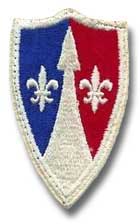
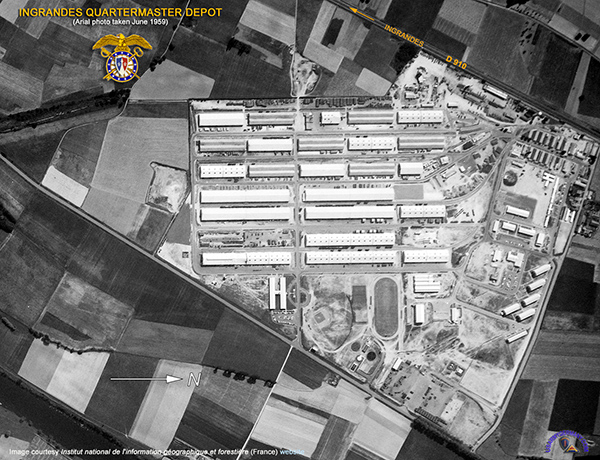
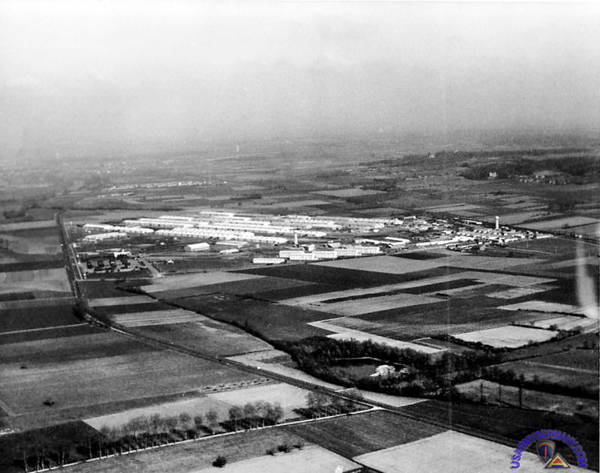
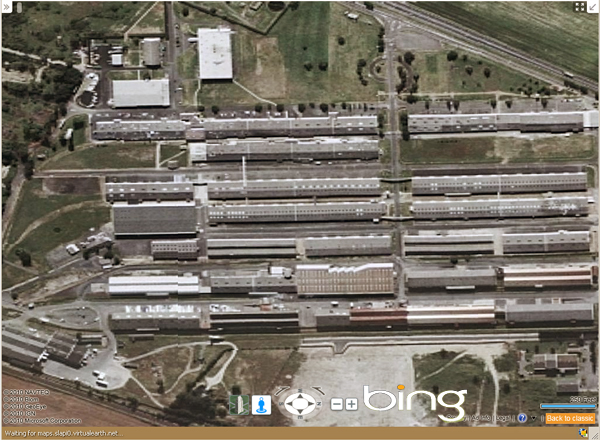
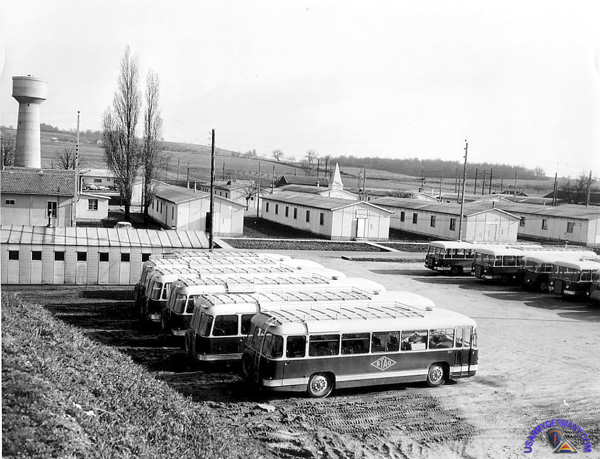
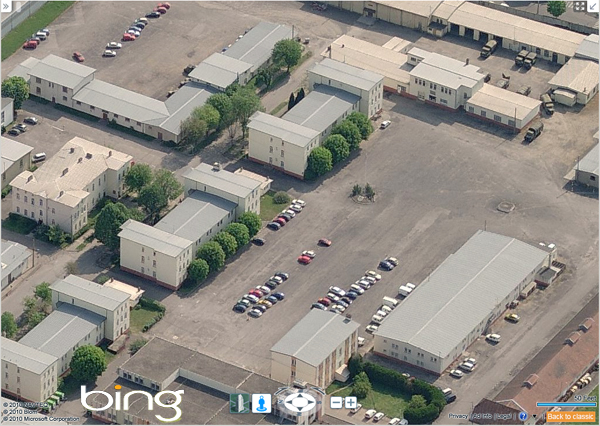
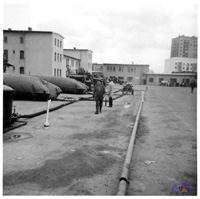
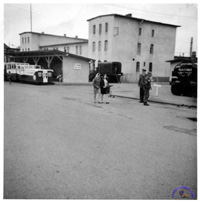
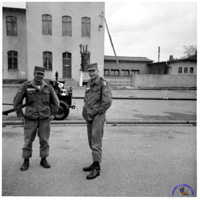
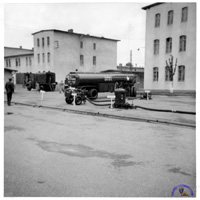
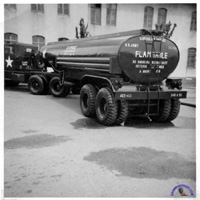
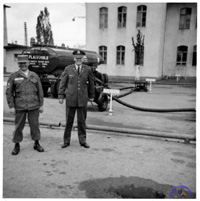
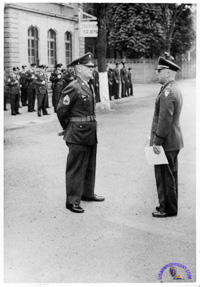
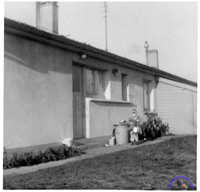
 400.jpg)
